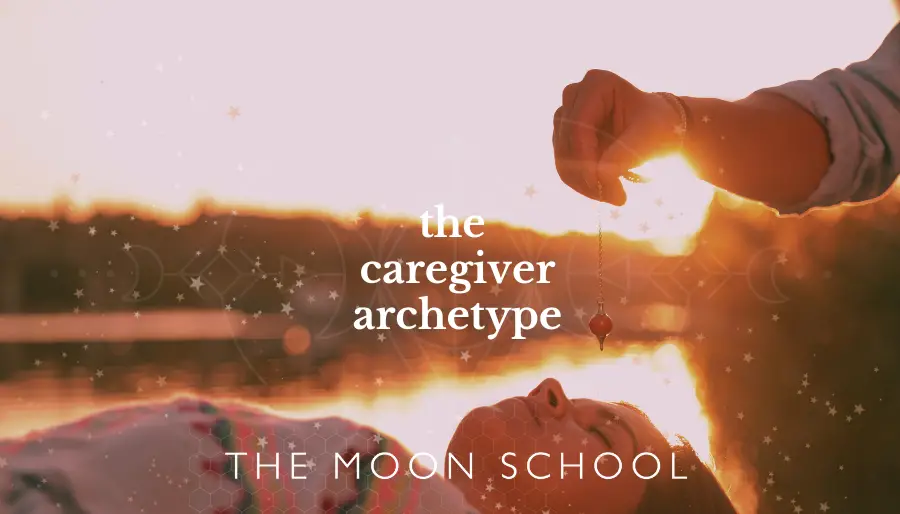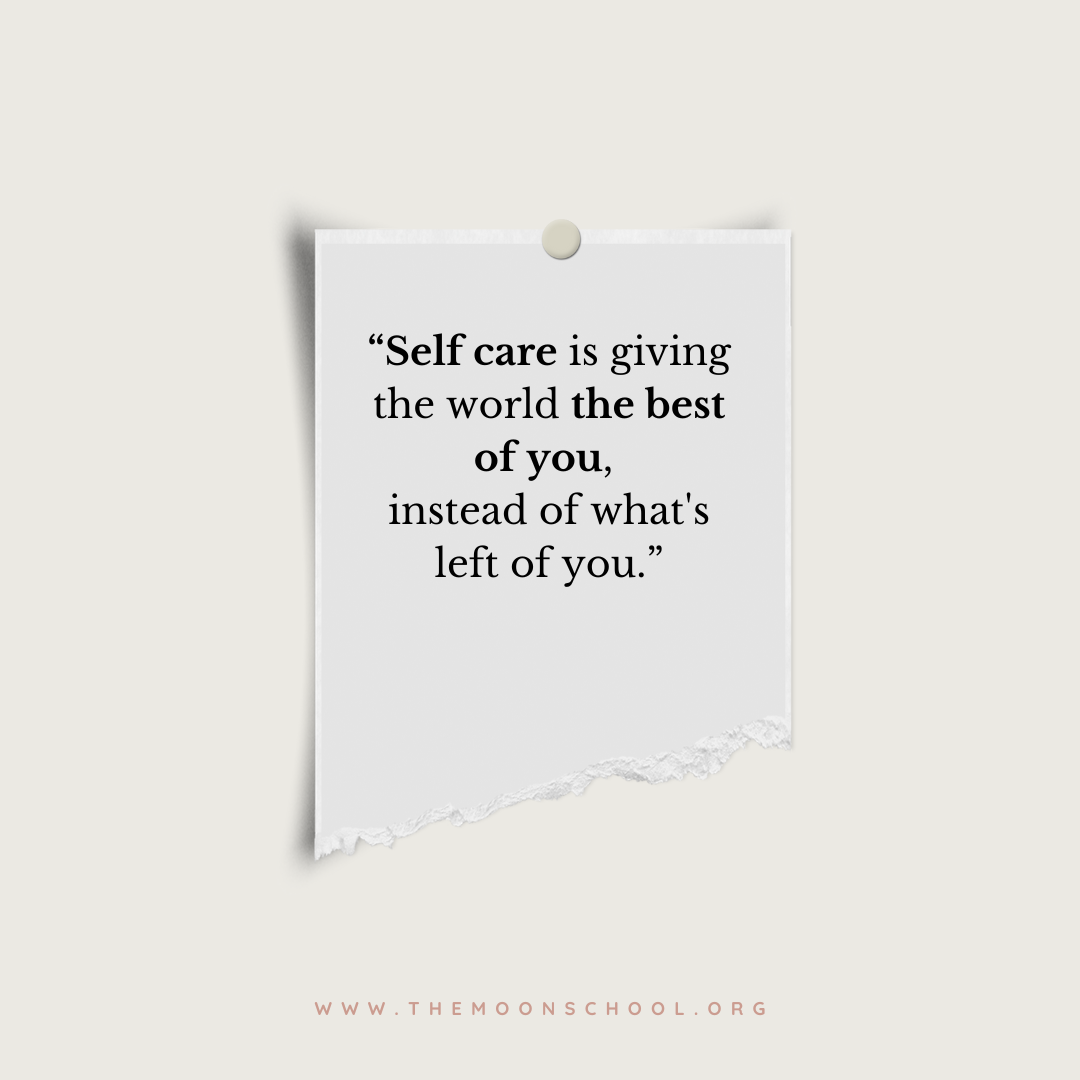The caregiver archetype is characterized by a deep desire to help and care for others, often at the expense of one’s own well-being. If you find yourself constantly putting other people’s needs before your own, this may be a dominant energy type running through you.
Caregiver archetypes aren’t limited to those who work in healthcare or social services. This essence of kindness and generosity can manifest in anyone who feels a strong sense of responsibility for the welfare of others.
If you embody the caregiver archetype, you may find yourself drawn to professions that involve nurturing and helping others, such as teaching, counseling, or coaching.
However, being a caregiver is not always easy!
This self-sacrificing role can be emotionally and physically draining. It is exhausting to constantly put others first, so it’s really important to recognize when you need to take a step back and care for yourself. Without knowing their limits, caregivers can risk burning out, and becoming unable to help others at all.
Defining the Caregiver Archetype
To understand the caregiver archetype – and how it differs from the other archetypes that may express through you (especially the mother archetype!) it’s important to understand the concept of archetypes. So if this is new to you, here’s a quick explanation…
What is an Archetype?
An archetype is a universal symbol or energy pattern.
It’s a bit like a blueprint, or essential form that crosses space and time, and are universally recognizable.
Archetypes are a part of our psyche and they exist in the collective unconscious. Recurring motifs that can be found in characters in mythology, literature, and art, archetypal energies cross almost all cultures and time periods.
Carl Jung, the Swiss psychiatrist first, introduced the concept of archetypes, though in truth they are much older. Interestingly, humans are programmed to recognize and respond to archetypes – this isn’t something we can switch off, and it often happens on a subconscious level. Ultimately, they represent fundamental human experiences and desires that are shared by all people.
As individuals, we tend to inherit archetypal energies from our ancestors. Though you can also embody archetypal patterns or behaviors that don’t seem to bear any relation to the rest of your family!
YOU MAY BE INTERESTED IN: 7 Feminine Archetypes and How to Embody their Power
Traits, qualities, and characteristics of the Caregiver Archetype
Although this energy may appear pretty simple and straightforward, the caregiver archetype definition can get complex pretty quickly! So let’s look first at what could be described as their most positive traits.
Empathic: Caregivers are usually able to understand and feel the emotions of others. With their big heart, they can put themselves in someone else’s shoes and really understand their perspective. This enables them to connect closely, providing exactly the right support and comfort that’s needed.
Compassionate: People with a strong, embodied caregiver archetype have a deep sense of concern and care for others. They’re usually gentle folk. And it’s their innate awareness of another’s suffering, that keeps them motivated to help and serve.
Patient: As parents, they’re the ones who never lose their rag! Caregivers have the ability to remain calm and composed in difficult situations, and crucially, are able to wait for the right moment to act.
Selfless: Caregiver archetypes prioritize the needs of others over their own. They’re willing to make sacrifices in their own lives, to ensure the well-being of those they care for.
Nurturing: The caregiver lives with a natural inclination to nurture and care for others. This also tends to enable them to create a safe and supportive environment (which, in turn, tends to attract more people to care for!)
Dependable: The caregiver archetype is one of the MOST reliable and consistent. As a relentlessly kind soul, the caregiver can be counted on to provide support and assistance whenever it’s needed.
Adaptable: Caregivers often have this supernatural ability to adjust their approach to anything, to meet the changing needs of the people they’re caring for.
Great communication: Caregivers are skilled at communicating with others, and are able to listen actively and express themselves clearly.
Resourceful: These are people who are able to find creative solutions to all sorts of problems and challenges. Somehow, they’re able to make the most of the resources available to them.
Resilient: Caregivers are often able to bounce back from setbacks and challenges, maintaining their commitment to their work, even in very difficult circumstances.
Weaknesses and shadow side of the caregiver archetype
Despite being highly competent, motivated and deeply loving characters, caretaker archetypes aren’t immune to the shadow.
The shadow is part of our psyche that contains all the personality traits and qualities that we’ve suppressed and rejected. This usually happens totally unconsciously, and we all do it!
WANT TO LEARN MORE? ACCESS the entire archive of articles on the shadow HERE
Some of the weaknesses and shadow side of the caregiver archetype include:
Over-identification: It’s possible for these women and men to become so invested in caring for others, that they lose sight of their own needs and identity.
Codependent: Caregiver archetypes can become overly dependent, or develop unhealthy attachments to the people they care for. Whether it’s needing to be needed, or issues with people pleasing, there is any number of psychological issues that can arise in this archetype. These may lead to feelings of resentment and burnout, and may even ultimately harm both parties in a relationship.
Burnout: Caregivers may become overworked and overwhelmed by the demands of caring for others, resulting in physical, emotional, and mental exhaustion.
Guilty: One of the most common caregiver archetype characteristics with a negative spin, is feeling guilty for not being able to do more. Or alternatively, for actually taking time for yourself, which can lead to feelings of resentment and frustration, or low self-esteem.
Resentful: Caregiver archetypes may harbor feelings of resentment, either towards the people they care for, OR towards others. For example, those who don’t share caring responsibilities (but possibly should).
Enabling: This is a common shadow side in those people caring for loved ones, so watch out for it! You may inadvertently enable negative behaviors or patterns in the people you care for. This is especially risky for mother who cannot let their children grow up.
CURIOUS? READ THIS POST: What is the Devouring Mother Archetype?
Control issues: Caregivers may struggle with control issues, especially if they struggle to let go of their caregiving responsibilities or trust anyone else to take care of their loved ones.
Self-neglect: These kind and generous folks may ironically end up neglecting their own health and well-being because they’re putting SO much effort into caring for others.
Emotional detachment: Another sad shadow that can develop for this archetype, is emotional detachment. Caregivers may actually become numbed out as their big open heart closes, due to the demands of their work. This can lead to a sense of disconnection and isolation.
Martyrdom: Another huge potential weakness of the caregiver archetype is the tendency towards martyrdom. This means – sacrificing your own needs and desires for the sake of others and then resents them for not appreciating your sacrifices. This can lead to feelings of bitterness and resentment, and may ultimately break down relationships.
Examples of the Caregiver Archetype
Do you identify with the caregiver archetype?
It may not be a dominant energy type within you – people usually have many archetypes that make up the wholeness of who they are. But if you find yourself drawn to certain professions or roles that allow you to care for others, then it could be something to explore. Some examples include:
- Nurse or healthcare worker
- Social worker
- Teacher or mentor
- Parent or grandparent
- Volunteer at a shelter or food bank
As a caregiver, you may also find yourself taking care of others in your personal life. This could include:
- Caring for a sick or elderly family member
- Taking care of children or grandchildren
- Helping a friend through a difficult time
- Being a listening ear for someone who needs support
When it comes to relationships, caregivers may find themselves attracted to partners who need care or support. This can create a dynamic where the caregiver gives more than they receive, which can lead to burnout and resentment over time.
So it’s vitally important for caregivers to set boundaries and take care of their own needs as well.
Caregiver archetype examples in literature, TV, and public figures
Mother Teresa: A real-life woman who dedicated her life to helping the sick and the poor. Known for her compassion and selflessness, her work has inspired many others to follow in her footsteps.
Florence Nightingale: Known as the founder of modern nursing. She cared for wounded soldiers during the Crimean War and revolutionized the way hospitals are run.
Yoda from Star Wars: A character from the Star Wars franchise known for his wise and nurturing personality. He takes care of Luke Skywalker and helps him develop his Jedi skills.
Dobby from Harry Potter: Known for his nurturing and caring personality, Dobby is a great helper to Harry in his fight against Voldemort.
Hagrid from Harry Potter: Another example of a selfless character who takes care of Harry when is parents can’t, helping him navigate the wizarding world.
Mrs. Doubtfire: A fictional character of a father who disguises himself as a Nanny, so he can take care of his/her children and help them through the challenges of divorce.
Importance of the caregiver archetype in society
The caregiver archetype is a truly important part of human nature. This impulse is a fundamental aspect of our personalities.
To build any kind of strong and healthy relationship, the presence of the caregiver archetype is essential. When you embody it, you are able to provide emotional support, care, and love to your friend, relation, or partner.
It also enables us to empathize with other people’s needs and to understand their feelings. This helps to create a deep and meaningful connection between people, which also helps create and nurture a sense of security and safety.
The trust and vulnerability this cultivates help to build a strong foundation for a long-lasting and fulfilling relationship. And the impact of THIS can ripple all the way through our lives, helping to create community and foster a culture of compassion and empathy.
The caretaker archetype in brand marketing and advertising
Brand archetypes are a way that different companies use marketing to position themselves, and to attract a certain kind of customer.
Brands often use the caregiver brand archetype to define themselves as a nurturing, supportive, and reliable force in the lives of their customers.
In fact, the caregiver brand has become pretty commonplace, as it creates the kind of trust that can be a real competitive advantage in our busy, busy world.
Many caregiver brands emphasize their commitment to customer service. For example, by offering personalized support, responding quickly to customer inquiries, and providing helpful resources and advice, they’re advertising the caregiver brand archetype in such a way that makes their customers feel totally looked after.
Many businesses that describe themselves as being a “family company” are also drawing on the caregiver brand archetype. The unconscious connection that many people make between “family” and goodness, wholesomeness, and care, means the dots are joined already.
Another way the caretaker brand appears in marketing is by emphasizing a commitment to social responsibility and sustainability. Organizations that position themselves as caregiver brands often take a proactive approach to social and environmental issues. For example, reducing their carbon footprint, supporting local communities, and donating to charitable causes. This usually serves to create a sense of goodwill and trust among customers, who feel that the brand is committed to making a positive impact on the world.
10 ways to explore and embrace the caregiver archetype
Ok, let’s get back to how this archetype shows up on a personal level.
Whether you already have a super-strong caretaker impulse and you want to channel it in a more healthy way… OR if this feels like a totally alien concept to you, here are ten ways you can start to explore and embrace this beautiful, comforting, and OH so necessary archetype:
Offer to help others
Whether it’s a friend, family member, or complete stranger that you notice on the street, offering to help someone in need is a great way to embrace your caregiver archetype. It could be something as simple as carrying groceries or helping them move furniture. You don’t need to fix all the world’s problems – helping one person out can be enough!
Learn to listen actively
Active listening is a really important skill for all people, but especially caregivers. When someone is talking to you, give them your full attention. This means you’re exquisitely in the moment with them, receiving their perspective, rather than simply waiting for your turn to speak!
Show empathy
Empathy is the ability to understand and share the feelings of others. You need to be on their level, really meeting them where they’re at. As a caregiver, it’s super-important to show empathy towards those you are caring for.
Cultivate patience
Patience is a virtue! Especially for caregivers. The people you care for may have different needs to yours, or take a little (or a lot!) longer to do things. Being patient helps you provide better care, and become a more considerate helper.
Practice self-care
As a caregiver, it’s easy to neglect your own needs. This makes self-care a must. So remember to take care of yourself by eating well, exercising, and getting enough rest.
Improve your communication skills
Communication is key in any relationship. As a caregiver, it’s important to be clear and concise when communicating with those you are caring for.
Be more flexible
Life can be unpredictable. One of this archetype’s greatest strengths is flexibility and adaptability – something I think we’ll need a lot more of in coming years, as our world continues to change.
Embodying this archetype means cultivating more flexibility, and letting go of control sometimes.
Be reliable
When you make a commitment to someone, it’s important to follow through. Being reliable helps build trust and strengthens your relationships.
Be compassionate
Compassion is the ability to show kindness and understanding toward others. As a caregiver, it’s important to be compassionate toward those you are caring for.
(and one more…) Cultivate presence
Being present means giving your full attention to the person you are caring for. This helps them feel valued and appreciated.











